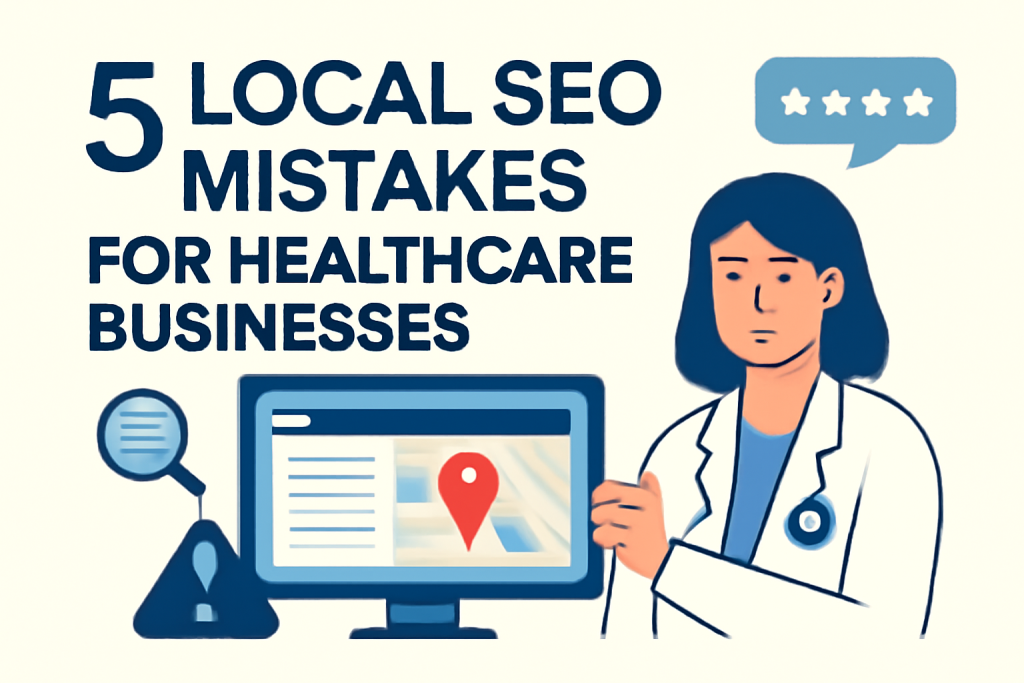In the digital-first world of healthcare, patients don’t just ask their neighbors for a doctor recommendation anymore—they ask Google… Local SEO is the key to unlocking this visibility, but many healthcare businesses are making costly local SEO mistakes healthcare. By avoiding these common local SEO mistakes healthcare, you can improve your online presence and turn casual searchers into new patients.
Local SEO is the key to unlocking this visibility, but many healthcare businesses are making costly local SEO mistakes healthcare that are holding them back. By avoiding these common local SEO mistakes healthcare, you can improve your online presence and turn casual searchers into new patients.
The #1 Local SEO Mistake: Neglecting Your Google Business Profile for Doctors
Avoiding Local SEO Mistakes Healthcare: Key Strategies for Success
Think of your Google Business Profile (GBP) as your practice’s digital front door… An incomplete profile is a classic local SEO mistake healthcare businesses make. A complete and active GBP is one of the most powerful signals you can send to Google that your practice is trustworthy and relevant.
These local SEO mistakes healthcare can lead to missed opportunities and hinder your practice’s growth.
Addressing these local SEO mistakes healthcare is crucial for maximizing your online reach.
Staying informed about local SEO mistakes healthcare can enhance your reputation in the community.
It’s essential to recognize local SEO mistakes healthcare to remain competitive in your area.
The Fix: Claim and fully optimize your Google Business Profile. Fill out every single field with accurate information, including your Name, Address, and Phone number (NAP). Add your hours of operation, a list of your services, and high-quality photos of your staff, waiting room, and exterior. Regularly use the “Posts” feature to share updates, health tips, or special announcements. A complete and active GBP is one of the most powerful signals you can send to Google that your practice is trustworthy and relevant.
Overcoming local SEO mistakes healthcare should be a priority for every practice.
Identifying local SEO mistakes healthcare will help you attract more patients.
By learning from local SEO mistakes healthcare, your practice can thrive.
Mistake #2: Ignoring Patient Reviews and Online Reputation Management
Online reviews are the modern version of word-of-mouth referrals. A steady stream of positive reviews builds social proof and trust, not just with potential patients but with Google’s algorithm as well. Ignoring reviews—or worse, a negative one—can be detrimental.
The Fix: Actively encourage your happy patients to leave reviews on platforms like Google, Healthgrades, and Yelp. More importantly, respond professionally and promptly to all reviews—both positive and negative. When responding to a negative review, be empathetic and never violate patient privacy by discussing specific medical details (HIPAA compliance is critical here). A professional response shows you care about patient feedback and are dedicated to providing excellent service.
Mistake #3: Lack of Location-Specific Content for Your Medical Practice
If your website content talks about general health issues without any local context, you’re missing a huge opportunity. Local patients are looking for local solutions. Your content should reflect this.
The Fix: Create location-specific content that answers the unique questions and concerns of your community. Publish blog posts on topics like “Flu Season Tips for [Your City] Residents” or “How to Prepare for Allergy Season in [Your State].” Use location-based keywords naturally in your website copy, headings, and meta descriptions. This strategy helps you rank for specific local searches and positions your practice as a helpful resource for the community.
To ensure success, avoid common local SEO mistakes healthcare that others make.
Mistake #4: How Inconsistent NAP Data Harms Your Local SEO for Healthcare
If your address is listed differently on your website, Google Business Profile, and other directories… This inconsistency is a critical error in medical practice local SEO and can prevent you from ranking in local search results.
The Fix: Perform a thorough audit of your online presence to ensure your NAP (Name, Address, Phone number) is consistent everywhere. Use a tool or manually check all relevant directories. By ensuring your information is identical across all platforms, you build trust with search engines and make it easier for patients to find you.
Mistake #5: The Dangers of a Slow and Non-Mobile-Friendly Website
In a fast-paced digital world, patients expect a seamless online experience. A slow-loading website or one that isn’t mobile-friendly will quickly cause potential patients to “bounce” and seek care elsewhere. Since most people are searching for healthcare on their phones, a poor mobile experience is a critical mistake.
The Fix: Prioritize the patient experience. Ensure your website has a responsive design that works perfectly on all devices, especially mobile phones. Optimize your website’s images and code to improve page speed. A fast, easy-to-navigate website not only improves your search rankings but also makes it easier for patients to book an appointment or find the information they need.
Conclusion: How to Fix Local SEO Mistakes and Attract More Patients
Local SEO isn’t a quick fix, but a consistent, long-term strategy that can significantly improve your patient acquisition efforts. By correcting these local SEO mistakes healthcare, your business can build a stronger online presence, earn the trust of your community, and ultimately, help more people. For more insights on how to leverage local SEO to grow your practice, check out our comprehensive guide on local SEO for healthcare patient acquisition.

